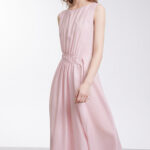A Journey into the World of Hanfu, China’s Timeless Traditional Clothing
Hanfu, the traditional attire of the Han Chinese, has a history that spans over three millennia. This elegant and intricate form of Clothing is more than just fabric and threads; it’s a symbol of China’s rich cultural heritage and a testament to its ancient civilization.
Embarking on a journey into the world of Hanfu is like stepping through a portal into ancient China. Each fold, each stitch, tells a story of a civilization that valued harmony, balance, and respect for nature. The Hanfu’s design is deeply rooted in the philosophical beliefs of Confucianism, Taoism, and Buddhism, reflecting the ethos of the society.
The Hanfu’s silhouette is characterized by its flowing lines and wide sleeves, which allow for freedom of movement and symbolize the expansiveness of the Chinese spirit. The traditional colors used in Hanfu are not chosen at random; they are imbued with meaning and significance. For instance, red symbolizes good fortune and joy, while yellow represents royalty and the divine.
Over the centuries, the Hanfu has evolved, adapting to the changing times while maintaining its core essence. From the elaborate dragon robes of emperors to the simpler attire of scholars and commoners, the Hanfu has been a canvas for the expression of social status and personal identity.
Today, the revival of Hanfu is not just a fashion trend; it is a cultural renaissance. Young people in China are embracing Hanfu as a way to reconnect with their roots and to express their national pride. The Hanfu movement is a vibrant community that organizes events, shares knowledge, and promotes the appreciation of traditional Chinese clothing.
As we explore the world of Hanfu, we delve into the history, the craftsmanship, and the stories that each piece of clothing carries. From the meticulous embroidery to the careful selection of materials, the Hanfu is a masterpiece of textile art that continues to captivate hearts and minds around the world.
Whether you are a fashion enthusiast, a history buff, or simply someone who appreciates the beauty of traditional clothing, the world of Hanfu offers a rich tapestry of experiences waiting to be discovered. So, let us don the Hanfu and embark on this timeless journey together.
Understanding Hanfu’s Cultural Significance
Hanfu is not merely a fashion statement; it is a cultural artifact that carries the weight of history. The traditional clothing is a reflection of the values and aesthetics of ancient China, embodying principles such as the Mandate of Heaven, filial piety, and the harmony between humans and nature.
Each component of the Hanfu has a specific purpose and meaning. The sash, for example, is not just a means to fasten the garment; it represents the moral and social bonds that hold society together. The collar, which is often round, symbolizes the heavens, while the square-shaped hem of the garment represents the earth, illustrating the connection between the human world and the cosmos.
The revival of Hanfu is a testament to the enduring appeal of traditional culture and the desire to preserve and celebrate one’s heritage. As we learn more about the Hanfu, we gain a deeper understanding of the Chinese civilization and its profound impact on the world.
Exploring Hanfu Styles and Variations
While the Hanfu shares common design elements, there is a rich diversity in styles and variations that cater to different tastes and occasions. From the formal court attire to the more casual everyday wear, each style has its unique charm and historical context.
Some of the most iconic Hanfu styles include the Zhiju, a long robe with a cross-collar and a belt, often worn by officials and scholars; the Ruqun, a dress with a high waistline and flowing skirt, favored by women for its elegance and grace; and the Pianfu, a short jacket and skirt combination, which is both practical and fashionable.
Understanding the different styles of Hanfu allows us to appreciate the versatility and adaptability of traditional Chinese clothing. It also provides an opportunity to explore the nuances of Chinese history and culture through the lens of fashion.
Hanfu in Modern Times
Despite its ancient origins, Hanfu is very much alive in the modern world. The resurgence of Hanfu has been fueled by a growing interest in traditional culture and a desire to reconnect with one’s roots.
Today, Hanfu can be seen on the streets of Chinese cities, at cultural festivals, and even in online communities where enthusiasts share their passion for this timeless attire. The Hanfu movement has also inspired a new generation of designers and artisans who are reinterpreting traditional designs for a contemporary audience.
As Hanfu continues to gain popularity, it serves as a bridge between the past and the present, offering a unique perspective on Chinese culture and identity. The Hanfu’s timeless appeal lies in its ability to adapt and evolve while staying true to its cultural roots.
Conclusion
In conclusion, the world of Hanfu is a fascinating and enriching journey into the heart of Chinese culture. By exploring the history, styles, and significance of this traditional clothing, we gain a deeper appreciation for the values and aesthetics that have shaped Chinese civilization.
Whether you choose to wear Hanfu as a form of cultural expression or simply enjoy learning about its rich heritage, the Hanfu offers a window into the soul of China and its enduring legacy.






